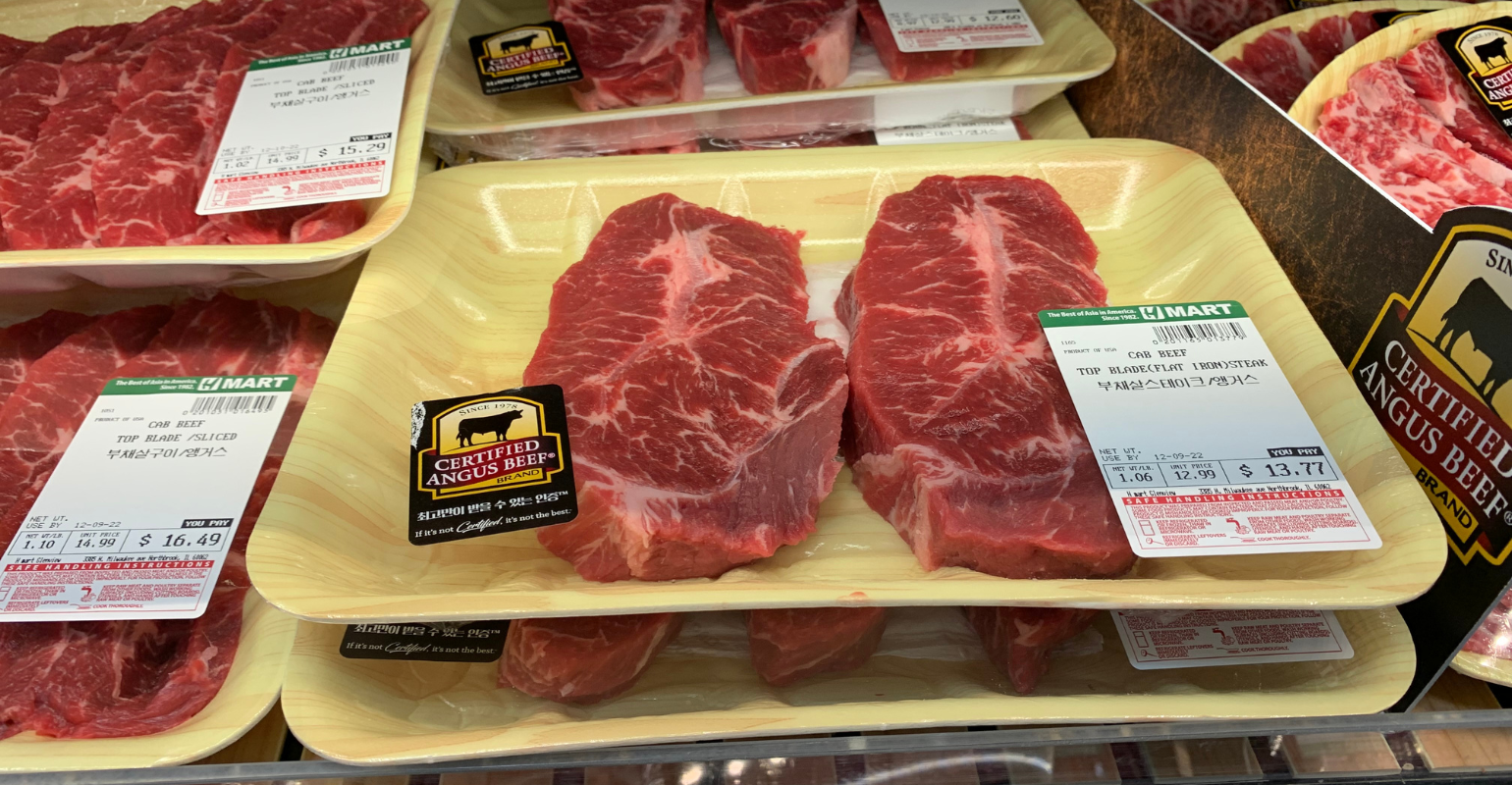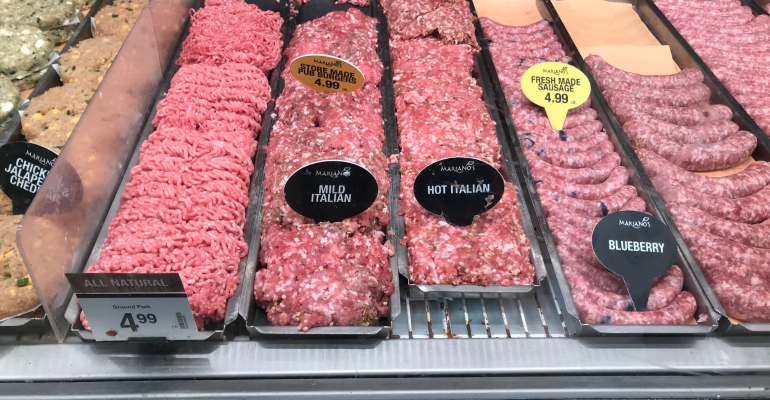Food inflation might be easing, but the meat sector still is being impacted by the sky-high price increases of the last several years.
While meat prices rose 1.1% in 2023 for an average of $4.46 a pound, significantly lower than the 17.6% increase of the last three years, total meat department pound sales were down 1.9% with decreases of 1.3% for fresh meat and 3.1% for processed meat, reports Circana, a Chicago-based market research firm.
The high prices mean translate to shoppers eschewing higher-priced proteins and cuts while continuing to embrace the traditionally lower-cost selections.
In a 2023 consumer survey by the Centennial, Colo.-based National Cattlemen’s Beef Association (NCBA), 20% of respondents indicated that they planned to buy fewer steaks compared to a year earlier, while just 14% intended to purchase more. In addition, 19% of the shoppers noted that they planned to purchase less roast beef, with 10% intending to buy more.
The average per pound price of beef roasts was $7.35 in December 2023, up from $6.95 in December 2021, reports the U.S. Department of Agriculture (USDA). The average price of beef steaks was $10.65 in December versus $9.93 two years earlier.
Twenty-four percent of NCBA survey respondents, meanwhile, indicated that they planned to buy more chicken, with just 6% intending to purchase less, and 16% noted that they would be purchasing more ground beef, with 11% buying less.
The average price of fresh whole chicken was $1.96 a pound in December, up from $1.61 in December 2021. Bone-in chicken legs had an average price of $1.86 compared to $1.73 two years earlier. The average ground beef price was $5.21 a pound in December, up from $4.60 in December 2021.
In addition, 10% of consumers indicated that they planned to purchase more pork, with 17% noting that they would be buying less. The average price of pork chops was $4.26 in December, up from $4.02 in December 2021.
The survey also revealed that consumers want opportunities “to stretch their dollars,” which includes the use of cost-saving coupons and weekly features, said Laura Hinton, NCBA senior director of channel marketing.
Shoppers are also seeking meat selections that provide benefits which go beyond price, said Anne-Marie Roerink, president of 210 Analytics LLC, a San Antonio-based market research and marketing strategies firm and author of the Power of Meat 2023 report, published by Arlington, Va.-based FMI—The Food Industry Association and the Washington, D.C.-based Foundation for Meat & Poultry Research & Education.
“It is about value which encompasses much more than the lowest dollar amount,” she said. “Value includes a nod to quality and taste.”
It is vital for retailers to consistently remind shoppers about that value, such as by spotlighting how meats deliver highly nutritious energy and sustenance and not empty calories, Roerink said.
“Continued consumer education about protein, other nutrients, and sustainability remain important areas for supporting sales,” she said. “It is driving the permissibility and favorability of eating meat and poultry versus losing dollars to other protein sources.”
Taste is tops
“Great tasting” and “Good value for the money,” meanwhile, were the top two elements cited by consumers aged 18 to 64 in a 2023 nationally representative NCBA survey on protein considerations when dining at home. Next were: “fits my budget,” “safe to eat,” “know how to prepare it,” “pleasurable eating experience,” “good for many types of meals,” “nutritious,” “great source of protein,” and “quick/fast to prepare.”
Operators can also spur greater interest in meat by offering ready-to-cook and full-meal solutions in oven-ready trays in supermarket delis, Roerink said, which is where many smaller households and younger shoppers engage with meats.
In addition, retailers can create a more positive meat pricing perception by spotlighting the deli offerings, she said, noting that while meat department shoppers tend to compare prices among the different cuts, consumers purchasing value-added deli meats often analyze the cost versus eating at restaurants.

Many cost-conscious shoppers are cutting back on higher-priced meat selections, including steaks.
While prepared meats typically are more expensive than conventional selections, Roerink said convenience-focused items are “alive and well,” and “that will likely mean strength in years to come.”
“We’re at an inflection point where the boomer share of dollars is shrinking and the millennial share is rising,” she said. “Millennials make far fewer trips to the meat department but are more highly engaged with the deli and produce departments. Be where the shopper is, instead of trying to change their behavior.”
That can include using smaller island refrigerators to merchandise chicken in produce departments or burgers with side dishes at store entrances, Roerink said.
Retailers will further attract millennials by selling meats in pre-portioned, freezer-ready, or vacuum packaging for freezing and use over time as the buyer segment tends to “purchase meat less often, but buy more when they do,” she said.
Quantity is key
Package size is also playing a key role in luring price-conscious shoppers, said Russell Zwanka, director of the food marketing program and associate professor of food marketing at Western Michigan University in Kalamazoo. While many butchers previously created “value” selections by making the packs as large as possible with a lower price per pound, steeper overall meat costs necessitates that they now focus on offering smaller-size packs, he said.
The average price of boneless chicken breasts, for instance, which retailers often include in larger value packs, was $4.08 a pound in December 2023, up from $3.73 two years earlier, the USDA reports.
Nevertheless, operators can still boost interest in higher-priced meats by being creative, Zwanka said. Methods may include spotlighting local ranchers and the origin of beef selections, he said, noting that “many people will buy a steak just because you made it interesting. Knowing the source of all our foods is desired by customers.”
Merchandising more health-oriented products will trigger further interest in meat, Zwanka said, which includes grass fed, organic, and selections that underwent development without the use of antibiotics and hormones. “Most people who avoided meat because it upset their stomachs have figured out that grass fed alleviates the digestion part of the eating experience,” he said.
Highlighting the steps suppliers are taking to ensure products are safe and nutritious will add to meat’s appeal as well, Roerink said. She added that merchandisers also should help prevent the spread of falsehoods about negative health ramifications from consuming meat and the detrimental effect that raising livestock has on the environment.
“About one-third of consumers have concerns about the impact of animal agriculture on the planet,” she said. “The greenhouse gas conversation has stuck with consumers even if they have little idea of what it means or what the true contribution of animal agriculture is. It is crucial to show and talk as much as possible about all the progress made and the actual impact.”
Merchandisers should post favorable data on their websites, apps, packages, and in-store signage, she said. That can include noting that beef is an excellent source of protein and supplies such nutrients as B-vitamins, zinc, and iron, said Jill Rittenberg, NCBA senior executive director of channel marketing.
“Providing store staff and management with accurate facts and information on such topics as animal antibiotics and hormones can make great strides in dispelling misinformation,” she said.
That is vital as 70% of consumers indicated that they often, always, or sometimes consider how food was raised when making purchasing decisions, an NCBA consumer survey found.
In addition, 22% of survey respondents indicated that they have concerns with animal welfare; 16% on the use of hormones; 14% on antibiotic usage; 13% on feedyard/feedlot conditions; and 12% on sustainability or the environmental impact.
“Sharing facts and basic myth-buster training to staff and management can help them field questions that may arise from more curious shoppers,” Hinton said. Retailers can provide additional details via QR codes at the point of purchase, she said.
“Staying on top of trends, including social, environmental, and political, is the most important thing that retailers can do,” Zwanka said. “Ensure you are addressing them through the regular communication channels, including social sites and in-store communications.”





